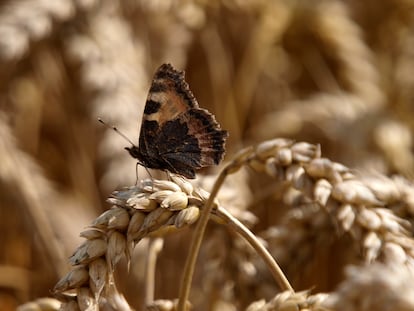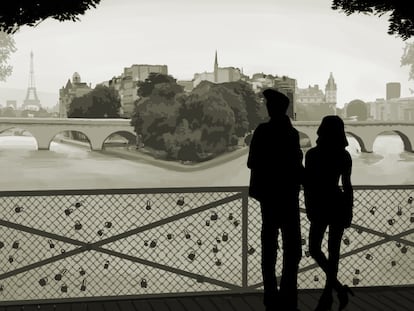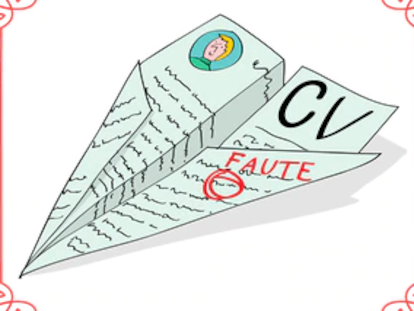A world without butterflies: The alarming decline of a vital species
Half of the lepidoptera species have disappeared from various regions in Spain and Europe, while in the United States, nearly a quarter have been lost this century alone
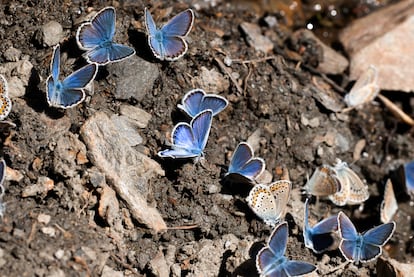
With just one month left until spring, Rob Wilson resumed a routine he has followed since 2018: on the last weekend of February, he ventures into the countryside near Colmenar Viejo in Madrid, where he lives. From then until the end of summer, sometimes on his own and sometimes accompanied by his colleague Juan Pablo Cancela, he takes the same walk each time — from the nearby stream to the mountain — in search of butterflies. While not enough time has passed for his observations to have scientific validity, Wilson has noticed a decline in the number of lepidopterans. The rare species are particularly scarce. His observation mirrors a global trend. In Spain, Europe, the United States, and other regions with reliable data, the landscape is the same: a world with fewer and fewer butterflies.
“The easiest thing is to choose a site close to your home. I have one in Colmenar Viejo,” says Wilson, an entomologist at the Museo Nacional de Ciencias Naturales (MNCN-CSIC). “You go to that same spot every week between March and September. And you walk a route of one to two kilometers, with an imaginary box two and a half meters on each side and five meters in front of you. Basically, you take note of all the butterflies that enter your imaginary box. That’s what’s called a transect,” explains Wilson.
Cancela, also an entomologist at the MNCN, continues: “Many species are easy to identify while they’re flying, but some are more complicated. For those, we carry a butterfly net — we have a permit from the Madrid regional government. If there’s a species that’s difficult to identify, we capture it, identify it, and release it.”
This is how they estimate the abundance of butterflies in Colmenar Viejo and globally. “To observe trends, we need more years of data. But in these eight years, species that were once abundant are now scarce, and others that were rare to begin with are no longer seen,” says the British ecologist, who resides in Colmenar Viejo.
In the United States, dozens of scientists like Wilson and Cancela, along with hundreds of volunteers, have been doing the same thing since the early 2000s. The results of their transects have just been published in the journal Science and are alarming: for the 342 species with statistically significant data, the U.S. has lost 22% of its butterfly population since 2000. For 107 species, the losses exceed half of their numbers.
These declines are happening across all latitudes and bioclimates, but are particularly severe in southern regions, which are more vulnerable to the heat and droughts driven by climate change. This connection is confirmed by the few species that have thrived — only 3% of species are growing significantly. Two-thirds of those that have increased in number are primarily found in Mexico.
Collin Edwards, a biologist at Washington State University and the first author of this extensive study, explains: “Many of those that are increasing are found primarily in Mexico and/or Central America.” He adds: “This is consistent with our finding that butterfly species tend to thrive at the northern edges of their ranges, which is what we would expect to see in the northern hemisphere with a warmer climate.” In other words, subtropical species are moving northward.
The decline observed in the United States is even more pronounced in Europe. Where long-term data exists, the longer the time series, the worse the situation for butterflies. Since 1992, Belgium has lost a third of its butterfly species, and the populations of the remaining species have declined by 30%.
In the United Kingdom, with its long tradition of lepidopterists, 8% of butterfly species have disappeared since 1976, and the global population of these insects has shrunk by half.
However, it is the Netherlands that seems to be heading towards a world without butterflies. A 2019 study, using the archives of natural science museums to estimate butterfly abundance since 1890, concluded that only 16% of the butterflies that existed at the end of the 19th century remain in the land of tulips. This conclusion, supported by more recent counts, paints a bleak picture.
The three Atlantic countries share common challenges that have contributed to this decline: very high human population densities and urbanization, which have reduced butterfly habitats; intensified agriculture, where monocultures do not support species diversity; and the widespread use of pesticides. New threats, such as climate change and the abandonment of rural areas, have compounded these issues.
Cristina G. Sevilleja, from the Netherlands Butterfly Conservation Institute, also leads the Butterfly Conservation Europe project. She explains: “In the west, the main cause of decline has been the intensification of agriculture, whereas in other regions, like Eastern Europe, the abandonment of traditional farming and livestock practices is transforming open areas into scrubland.”
Her organization is responsible for the Meadow Butterfly Indicator, an index used by the European Commission to assess biodiversity, specifically insect populations. The latest data from this indicator show that lepidopteran populations have decreased by 32% in the European Union and by up to 36% across Europe as a whole.
Constantí Stefanescu, an ecologist at CREAF, has been studying butterflies in the Spanish region of Catalonia and the Mediterranean basin for decades and reports similar findings to those observed in the United States. “Over the past 30 years, butterfly populations have decreased by between 30% and 40%,” says Stefanescu, who is also a researcher at the Granollers Museum of Natural Sciences and heads the Catalan Butterfly Monitoring Scheme (BMS).
There are BMS programs across Europe, all of which monitor butterfly populations in the same way that Rob Wilson does in Colmenar Viejo. However, in Catalonia, systematic studies have been conducted since 1994. “Among grassland species, some have lost half their numbers. Among forest species, there have been some gains, but the average is a 20% decline,” adds Stefanescu.

With fewer years of study, the situation is even worse in Spain’s Cantabrian mountain range. Amparo Mora, a researcher at Picos de Europa National Park — the first protected area in Spain — highlights a threat that might seem counterintuitive: The abandonment of the countryside is causing the environment to become overgrown. This rewilding “is damaging biodiversity,” she explains.
The vast majority of butterflies, up to 90%, are meadow species and, like most insects, require open spaces full of flowers. However, the lack of large herbivores, whether wild or domesticated, is causing these spaces to become overgrown. Mora has been conducting transects in the Cantabrian park for nine years. The park was once home to 137 butterfly species, 60% of those found in the Iberian Peninsula. But over this period, “abundance has plummeted by 45%; we will need to wait another five or 10 years to see the full picture, but the numbers are already telling us something,” the researcher points out.
Spain’s far south, in Sierra Nevada, is home to more than half of Iberian butterfly species. They are also being monitored, but the data available is still too limited to predict their future. José Miguel Barea’s doctoral thesis, which has studied the Lepidoptera of the Penibetic mountain range for two decades, revealed mixed results. Of the 125 documented species, 13% are seeing significant population increases, 19% are in decline, and another 8% are stable. However, the remaining 60% show “uncertain” trends.
Climate change is driving a double process: on the one hand, generalist species are replacing specialists that depend on very specific microhabitats, and on the other, every year, these species are appearing at higher altitudes or further north. This follows a universal adaptation law: species migrate north, higher up mountains, or deeper into the seas.
Yolanda Melero, from CREAF-UB, and her colleague Pau Colom, from University of Barcelona, recently published a study on the same trends observed in the mountains, but in urban parks. Melero leads a project examining the state of urban butterflies in parks and green spaces in Madrid and Barcelona, such as Casa de Campo and Montjuïc. Their focus is on understanding the interaction between threats, particularly urbanization and climate change.
“In general, we have observed that the most specialist species — those with less capacity for dispersal — are doing worse,” says Melero. Colom, for his part, acknowledges that some species may even benefit, such as thermophilic species that are now colonizing cooler areas previously unsuitable for them. However, he adds: “When you look at the trends for the entire butterfly community in a location, most species are on the decline.” Additionally, the heat island effect in urban environments may make these areas even more inhospitable.
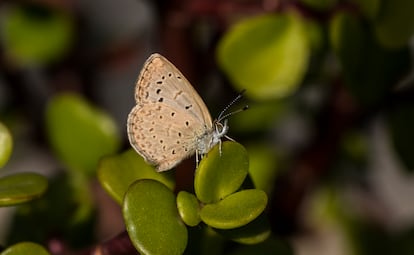
Miguel López Munguira, from the Centre for Research in Biodiversity and Global Change at the Autonomous University of Madrid, was José Miguel Barea’s thesis director and has been studying the butterflies of Sierra Nevada for more than 40 years. He was also one of the leaders of the team of specialists who produced the Atlas of Diurnal Butterflies of the Iberian Peninsula and the Balearic Islands in 2004. They are now putting the finishing touches on a new version of the Atlas, which may be published next year.
“Between 2004 and 2025, we haven’t lost any species, but we are going to lose them,” he says. “However, we are already losing many populations in many places,” he adds. Looking to the future, he believes that “a cataclysm awaits them if nothing is done.” Butterflies are simply too fragile to face such a powerful enemy. “Climate change is linked to changes in land use, leading to the intensification of agriculture, with its pesticides, which is harmful, as well as the abandonment of agriculture, which also harms animals that depend on open spaces,” he explains.
Sign up for our weekly newsletter to get more English-language news coverage from EL PAÍS USA Edition
Tu suscripción se está usando en otro dispositivo
¿Quieres añadir otro usuario a tu suscripción?
Si continúas leyendo en este dispositivo, no se podrá leer en el otro.
FlechaTu suscripción se está usando en otro dispositivo y solo puedes acceder a EL PAÍS desde un dispositivo a la vez.
Si quieres compartir tu cuenta, cambia tu suscripción a la modalidad Premium, así podrás añadir otro usuario. Cada uno accederá con su propia cuenta de email, lo que os permitirá personalizar vuestra experiencia en EL PAÍS.
¿Tienes una suscripción de empresa? Accede aquí para contratar más cuentas.
En el caso de no saber quién está usando tu cuenta, te recomendamos cambiar tu contraseña aquí.
Si decides continuar compartiendo tu cuenta, este mensaje se mostrará en tu dispositivo y en el de la otra persona que está usando tu cuenta de forma indefinida, afectando a tu experiencia de lectura. Puedes consultar aquí los términos y condiciones de la suscripción digital.
More information
Archived In
Últimas noticias
Welcome to the post-religion era: The idea of Christianity as the absolute truth has become obsolete
‘I thought you would like it’: The risky sexual practice popularized by TV shows and TikTok
The digitalization of tourism: ‘They promise experiences and gave us the worst possible one’
Mexican peso defies uncertainty with forecasts of a new period of stability in 2026
Most viewed
- Sinaloa Cartel war is taking its toll on Los Chapitos
- Reinhard Genzel, Nobel laureate in physics: ‘One-minute videos will never give you the truth’
- Oona Chaplin: ‘I told James Cameron that I was living in a treehouse and starting a permaculture project with a friend’
- Why the price of coffee has skyrocketed: from Brazilian plantations to specialty coffee houses
- Silver prices are going crazy: This is what’s fueling the rally


